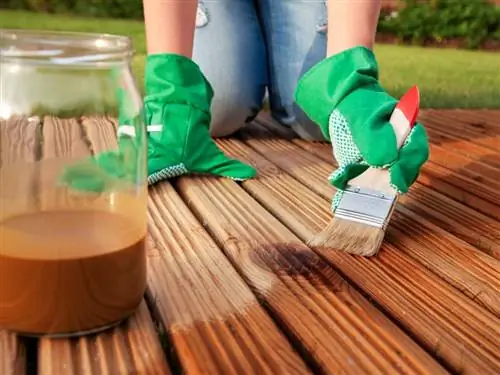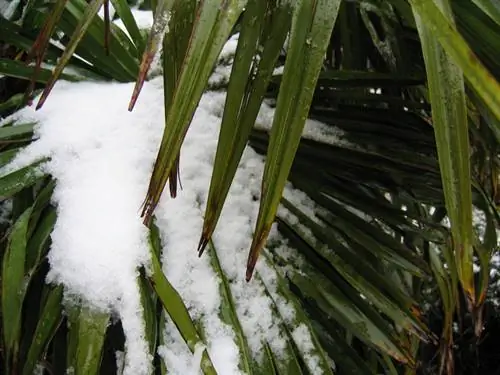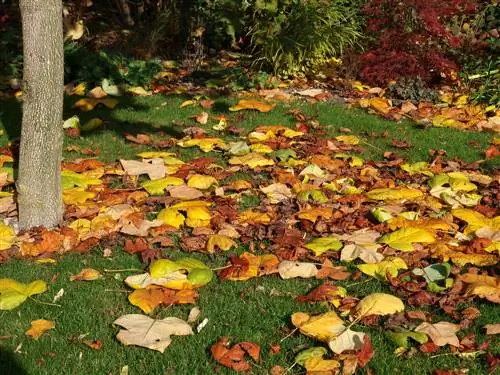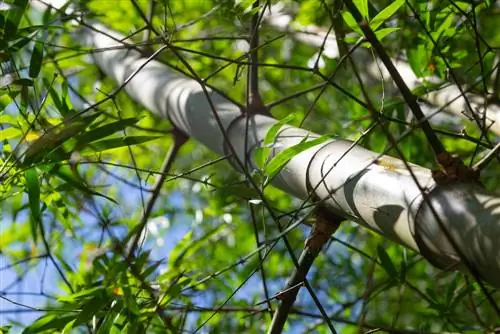- Author admin [email protected].
- Public 2023-12-16 16:46.
- Last modified 2025-06-01 06:02.
Now that there is a threat of cold, rain and snow again a few weeks later, not only the garden furniture, but also the fences, the terrace floor and the raised beds need our attention again if they survive the cold season unscathed should.
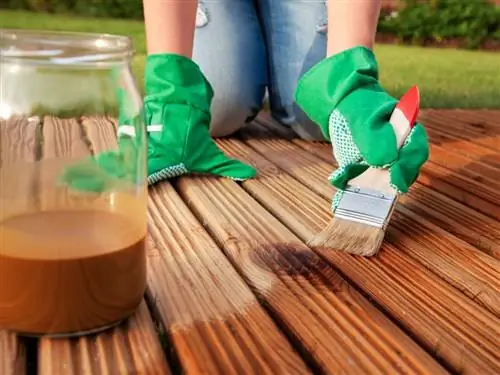
Now just randomly whitewashing all wooden surfaces is purely cosmetic and will be seen in the long run and will not last long. Therefore, take your time and first check all wooden surfaces for damage, because even the most careful application of wood preservatives is of little use to rotted or damp surfaces. If the pressure with a fingernail is enough to cause the strength to give way, the only solution is to thoroughly renovate the patio partition wall and if there is visible surface damage, the surface should be sanded over a large area.
A little preparatory work and the paint won't be off until much later
Water, known to be the biggest enemy of wood, causes mold to form on the surface, which is the ideal breeding ground for gradual rotting. The commercially available wood preservatives make the wood water-repellent down to the surface and regulate the moisture inside. However, the wood to be treated must be completely dry before painting. If the surface is too rough or the wood fibers are already sticking up, you will first need a few sheets of sandpaper (€7.00 on Amazon) or, even better, the courageous use of the orbital sander. The same level of care must be taken if flaking components of the previous coat are found, which may still be able to be removed down to the raw wood.
Take special care with wooden furniture and floor coverings
For exotic types of wood such as teak or eucalyptus, a particularly thorough care treatment is required in the last weeks of summer. After you have completely cleaned of grease, dirt and other contaminants and are completely dry, a deep treatment with hardwood oil is recommended. This is different for objects made of softwood and coniferous wood, which you can first treat with a thin-layer glaze and, after drying, with an additional layer of varnish to protect against weathering, aging and vermin infestation. Then let it dry thoroughly again and store it in a garden shed or a weather-protected cellar in preparation for hibernation. Everything that has to stay outside due to its size can then be covered with a suitable protective cover so that moisture, dirt and vermin cannot harm the valuable garden interior. However, foils and fabric tarpaulins must not lie too close to the wood, otherwise the moisture regulation from the inside to the outside will be impaired.
Special case of wooden floor coverings and WPC
An outdoor wooden floor covering that is poorly protected or not protected at all for a long period of time will not last very long for its owners. In addition to extreme mechanical stress, it is exposed to significant fluctuations in humidity and temperature and needs your special attention. In general, only those products that the manufacturer expressly recommends should be used for sealing and care. This is particularly true for the often used Wood-Polymer-Composites (WPC) floors and planks, which are made of approx. 70/30 percent wood / plastics & synthetic additives.
Winterizing floor coverings
Here, too, cleanliness is the be-all and end-all when it comes to care. Therefore, the area to be treated should be thoroughly cleaned in dry weather with a scrubber and a sufficient amount of water. Regarding the drying time, plan at least a day or, even better, 48 hours before the protective impregnation begins. Applying two coats of paint has proven to be effective, so that fungi and sponges have little chance of lastingly attacking the protected wooden surfaces.
Raised beds, planters and your fence also need to be protected
And here it is particularly important to seal the particularly sensitive end grain surfaces perfectly. You can recognize end grain or head wood by the visible annual rings or their segments, which are often visible at the ends of solid wood. Moisture can penetrate here particularly quickly and easily due to the open porosity. Before applying the paint as evenly as possible, it is important to first carry out a thorough and in-depth cleaning before painting with wood protection oils, varnishes or glazes.
Wood preservatives - but which one is the right one?
When selecting the ideal AND non-harmful product, you should definitely contact an authorized specialist retailer. Wood preservatives are biocides, so certain precautionary measures must be taken when using chemicals. The Federal Institute for Occupational Safety and He alth (BAuA) regularly updates the wood preservatives approved for processing in Germany in order to protect consumers and of course our environment from possible dangers.

